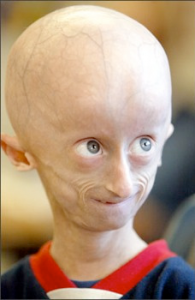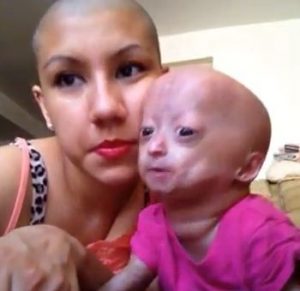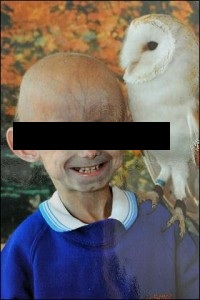 The Hutchinson-Gilford Syndrome (Progeria or HCGP) is a rare and fatal genetic disease characterized by an appearance of accelerated aging in children . Its name derives from the greek and means “premature aging”. There are different forms of Progeria and the most common is the syndrome Hutchinson-Gilford, the names of the doctors who first described in England (Dr. Jonathan Hutchinson in 1886 and Dr. Hastings Gilford in 1897). L ‘ HGPS , the classic form of Progeria is caused by a genetic mutation in the gene LMNA that occurs during the formation of sperm , and is of paternal origin, like many spontaneous mutations. The reason is due to the large number o f divisions that progenitor cells are necessary to become mature sperm.
The Hutchinson-Gilford Syndrome (Progeria or HCGP) is a rare and fatal genetic disease characterized by an appearance of accelerated aging in children . Its name derives from the greek and means “premature aging”. There are different forms of Progeria and the most common is the syndrome Hutchinson-Gilford, the names of the doctors who first described in England (Dr. Jonathan Hutchinson in 1886 and Dr. Hastings Gilford in 1897). L ‘ HGPS , the classic form of Progeria is caused by a genetic mutation in the gene LMNA that occurs during the formation of sperm , and is of paternal origin, like many spontaneous mutations. The reason is due to the large number o f divisions that progenitor cells are necessary to become mature sperm.
G ene LMNA produces a protein called Foil and which is located below the nuclear membrane, forming a kind of structural lattice where are anchoring many different proteins of the membrane itself and chromosomes . The mutation leads to the formation of a lamina shorter (progerin ) which becomes toxic to the cells, making it more susceptible to external damage and altering many internal connections from the functional point of view.

the small Antalya Rose Williams, a small web star suffering from Progeria
The Progeria Research Foundation (PFR) has played a key role in the discovery of the gene responsible for Progeria returning in April 2003 on the prestigious scientific journal Nature, the discovery of the gene responsible for Progeria, which took place thanks to the extraordinary work of a team of scientists from the PRF Genetics Consortium. According to the researchers, the process of premature aging typical of Progeria depend just from a defective Lamin A, which makes the nucleus unstable, causing instability phone.
Symptoms of Progeria closely resemble the normal human aging. but occur in young children. It affects a baby every 4-8 million, was in all ethnic groups and affects males and females equally. The children suffering from progeria who are apparently healthy at birth, in the first year of life show the first signs of the disease.
The main symptoms:
 The children suffering from Progeria are genetically predisposed to the onset progressive and premature cardiovascular disease and their death is almost always due to cardiovascular disorders popular. Suffering from cardiovascular disease, are: high blood pressure, onset of stroke, angina (chest pain due to reduced blood flow to the heart), enlarged heart and heart attack.
The children suffering from Progeria are genetically predisposed to the onset progressive and premature cardiovascular disease and their death is almost always due to cardiovascular disorders popular. Suffering from cardiovascular disease, are: high blood pressure, onset of stroke, angina (chest pain due to reduced blood flow to the heart), enlarged heart and heart attack.
Usually the progeria is not passed down through families and rarely seen more than one child in a family. Patients usually only live through adolescence, although some can reach 20 years. The HGPS is characterized by an autosomal dominant mutation (because it’s enough just to have a copy of the gene mutation for their appearance) < strong> sporadic (because it is a new mutation).
Children with Progeria age 8 times faster than normal, in practice, are creatures whose body is trapped in that of an old, albeit with mental development corresponding to their age, with intelligence and emotions linked to it.
For parents who have never had a child with Progeria, the possibility of giving birth to a child with HGPS is 1 in 4 million to 8 million, while in the case in which they have already had a child with Progeria , the risk that happen again, is about 2-3%. This increase in the percentage of risk is associated with mosaicism, a condition in which a parent has a genetic mutation of Progeria in a small percentage of its cells, but does not have the Progeria.
 As the gene mutation responsible for progeria has been identified, the Progeria Research Foundation ( PRF) has scheduled a diagnostic test with which to identify the change, the mutation of the gene that causes the syndrome HGPS. After the medical examination and history taking a blood sample is analyzed to search for the Progeria gene, with scientific precision, and so early, so you can treat children in a suitable way. There are now remedies for solving for progeria but only treatments to cure or prevent some of the consequences caused by the disease such as vascular risks, including stroke, heart attack and heart disease. The search, however, is trying to reverse the genetic process, trying to limit the damage of the toxicity of proge rin through the use of specific inhibitors that make it more unstable and therefore more easily eliminated. There are currently experimental protocols used different in France, Italy and the United States regarding the combined use of drugs already known to other diseases: pravastatin and zoledronic acid.
As the gene mutation responsible for progeria has been identified, the Progeria Research Foundation ( PRF) has scheduled a diagnostic test with which to identify the change, the mutation of the gene that causes the syndrome HGPS. After the medical examination and history taking a blood sample is analyzed to search for the Progeria gene, with scientific precision, and so early, so you can treat children in a suitable way. There are now remedies for solving for progeria but only treatments to cure or prevent some of the consequences caused by the disease such as vascular risks, including stroke, heart attack and heart disease. The search, however, is trying to reverse the genetic process, trying to limit the damage of the toxicity of proge rin through the use of specific inhibitors that make it more unstable and therefore more easily eliminated. There are currently experimental protocols used different in France, Italy and the United States regarding the combined use of drugs already known to other diseases: pravastatin and zoledronic acid.
These drugs act on the process of formation of the lamina (progerin) mature and thus interfere with its chemical modification (farnesylation), making the protein less toxic. Other studies have used an experimental drug, the lonafarnib, which would be able to block some of the devastating effects of the protein progerin: in all children treated with this drug, there have been positive effects, such as increased muscle strength or improvement of the condition of the blood vessels.
No comments:
Post a Comment